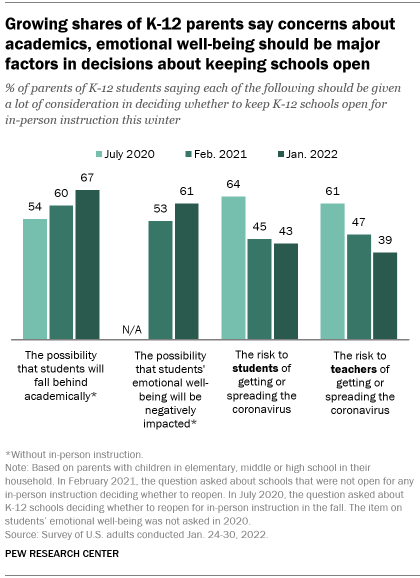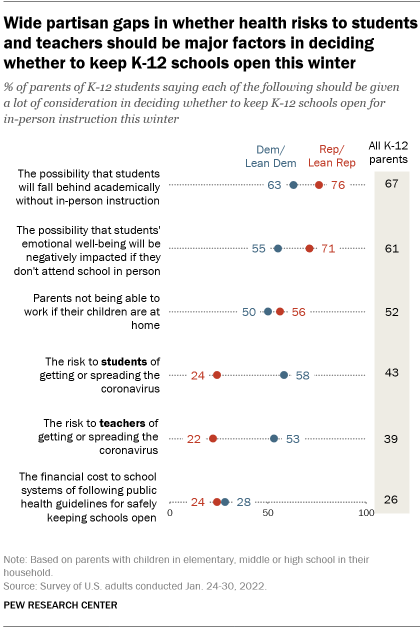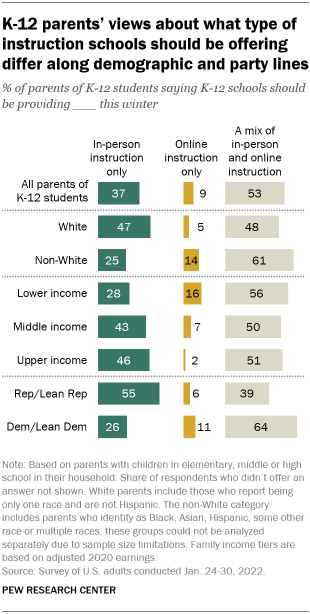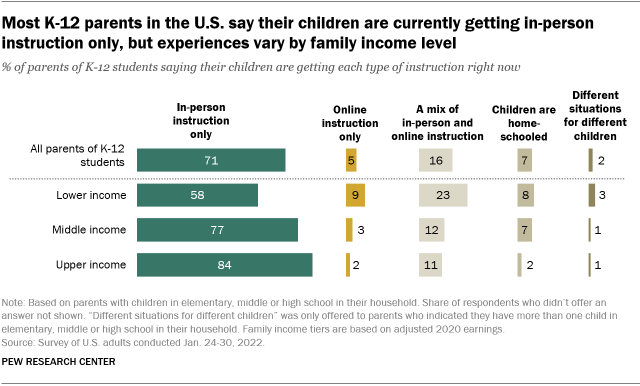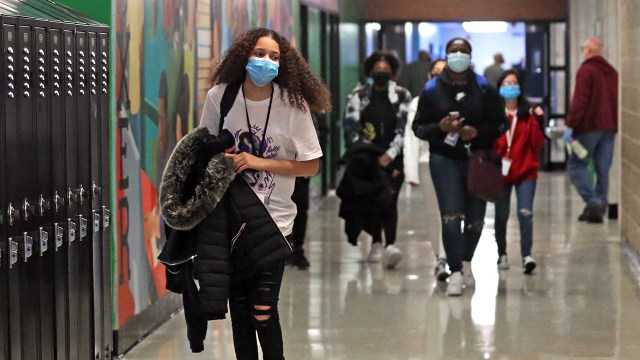
Amid a surge of COVID-19 cases due to the omicron variant, a narrow majority of parents of K-12 students (53%) say schools in the United States should be providing a mix of in-person and online instruction this winter, according to a new Pew Research Center survey. Some 37% say K-12 schools should be providing in-person instruction only, while just 9% say schools should be fully online.
When asked what factors schools should consider in deciding whether to stay open for in-person instruction this winter, most parents of K-12 students say a lot of consideration should be given to the possibility that students will fall behind academically (67%) or that their emotional well-being will be negatively impacted (61%) if they don’t attend school in person. Smaller shares cite parents not being able to work if their children are home (52%), the risk to students or teachers of getting or spreading the coronavirus (43% and 39%, respectively), and the financial cost to school systems of following public health guidelines for safely keeping schools open (26%).
This analysis explores parents’ views about the type of instruction that K-12 schools in the United States should be providing this winter and which factors parents see as important in deciding whether to keep schools open as the coronavirus pandemic continues. The analysis is based on a survey of 2,241 U.S. parents of children in K-12 schools who live in their household. The data was collected as part of a larger survey of 10,237 adults conducted Jan. 24-30, 2022. Everyone who took part is a member of Pew Research Center’s American Trends Panel (ATP), an online survey panel that is recruited through national, random sampling of residential addresses. This way nearly all U.S. adults have a chance of selection. The survey is weighted to be representative of the U.S. adult population by gender, race, ethnicity, partisan affiliation, education and other categories. Read more about the ATP’s methodology. Here are the questions used for this analysis, along with responses, and its methodology.
In July 2020, more K-12 parents said health risks to students (64%) and teachers (61%) should be given a lot of consideration in decisions about reopening schools than said the same about the possibility of students falling behind academically without in-person instruction (54%). By February 2021 – when many schools that had been providing online instruction were deciding whether to reopen for in-person instruction – six-in-ten parents said academic considerations should be a major factor, while smaller shares pointed to health risks to teachers (47%) or students (45%).
As has been the case throughout the pandemic, views about how schools should be handling instruction vary widely along party lines. Among parents of K-12 students, Republicans and those who lean Republican (55%) are far more likely than Democrats and Democratic leaners (26%) to say schools should be providing in-person instruction only this winter. A majority of Democratic parents (64%) – compared with 39% of Republican parents – say schools should be providing a mix of in-person and online instruction.
Republican parents are more likely than Democratic parents to say a lot of consideration should be given to the possibility that students will fall behind academically or that their emotional well-being will be negatively impacted without in-person instruction. Republicans are also more likely than Democrats to say parents not being able to work if their children are home should be an important factor in these decisions. In turn, larger shares of Democratic than Republican parents say the risk to teachers and students of getting or spreading the coronavirus should be given a lot of consideration.
Views also vary across demographic groups. White parents (47%) are far more likely than non-White parents (25%) to say schools should be providing in-person instruction only this winter, while non-White parents are about three times as likely as White parents to say schools should be fully online (14% vs. 5%, respectively). (The non-White category includes parents who identify as Black, Asian, Hispanic, some other race or multiple races; these groups could not be analyzed separately due to sample size limitations.)
Some 46% of upper-income parents and 43% of those with middle incomes say schools should be in-person only, compared with 28% of lower-income parents. Among lower-income parents, 16% say schools should be providing online instruction only; just 7% of those with middle incomes and an even smaller share of upper-income parents (2%) say the same.
These differences reflect, at least in part, the factors parents say should be given a lot of consideration in decisions about whether to keep schools open this winter. Non-White parents are more likely than White parents to say health risks to students (56% vs. 33%, respectively) and teachers (50% vs. 31%) should be major factors. By contrast, White parents (66%) are more likely than non-White parents (54%) to cite concerns that students’ emotional well-being will be negatively impacted if they don’t attend school in person. Similar shares of White (69%) and non-White (65%) parents say academic concerns should be given a lot of consideration.
Lower-income parents are more likely than those with middle or upper incomes to say the risk to students of getting or spreading COVID-19 should be given a lot of consideration in these decisions; those with upper incomes are the most likely to cite concerns about academics and students’ emotional well-being if they don’t attend school in person.
Most parents of K-12 students say their children are getting in-person instruction only
While a majority of parents think K-12 schools should be offering a mix of in-person and online instruction this winter, just 16% say this is the type of instruction their children are currently getting. About seven-in-ten (71%) say their children are getting in-person instruction only, while just 5% say their children are getting only online instruction. In October 2020, a plurality of K-12 parents (46%) said their children were getting online instruction only, while 20% said they were getting only in-person instruction and 23% said there was a mix.
Upper-income parents are the most likely to say their children are getting in-person instruction only: 84% say this in the new survey, compared with 77% of those with middle incomes and an even smaller share of those with lower incomes (58%). About one-in-ten lower-income parents (9%) say their children are getting online instruction only, while 23% say their children are getting a mix of in-person and online instruction. Just 3% of K-12 parents with middle incomes and 2% of those with upper incomes say their children are getting only online instruction, while about one-in-ten in each group say they are getting a mix.
Note: Here are the questions used for this analysis, along with responses, and its methodology.
